If you’re in the market for a mid-range smartphone that won’t break the bank, then looking at the Samsung Galaxy A54 vs Sony Xperia 10 V could be a good starting point, but which one is better? Find out in our comparison…
Both priced around $449 / £449 (or less), they both offer a triple camera system on the rear, a 5000mAh battery, and are available in a number of colours.
We’ll be looking at how the cameras compare on both phones, as this can play a massive part in how people choose a phone, and if that’s you, then you’ve come to the right place, as we’ve got over 100 years experience in photography…

Samsung Galaxy A54 5G (left) vs Sony Xperia 10 V (right). Photo Joshua Waller
Camera phone specs compared…
Here we go through some of the main specifications and differences between the two phones:
| Samsung Galaxy A54 5G | Sony Xperia 10 V | |
| Main rear camera | 50MP f/1.8 wide, OIS, AF | 48MP f/1.8 wide, OIS, AF |
| 2nd rear camera | 12MP f/2.2 ultra-wide | 8MP f/2.2 ultra-wide |
| 3rd rear camera | 5MP f/2.4 macro | 8MP f/2.2 telephoto, AF |
| Front Camera | 32MP f/2.2 (outputs 8MP) | 8MP f/2.0 selfie camera |
| Video | 4K, 30p (front and rear) | Full HD, 30p (front and rear) |
| Screen | 6.4inch 120Hz, 19.5:9 aspect | 6.1inch 60Hz, 21:9 aspect ratio |
| Battery | 5000mAh (wired, 25W) | 5000mAh (wired) |
| Size | 158.2×76.7×8.2mm | 155x68x8.3mm |
| Weight | 202g | 159g |
| Updates | 4yr OS, 5yr security | 2yrs OS / 3yr security |
| IP67 rating, Stereo speakers | IP65/68, Stereo speakers |
The main camera on the Samsung A54 gives pixel-binned images with 12.5MP, and on the Sony 10 V, the pixel-binned images are output at 12MP. It’s also worth nothing, that unless specified, the majority of cameras on these phones have fixed-focus (FF), and only a few have auto-focus (AF). This is fairly common on mid-range phones, but having autofocus on the ultra-wide-angle and selfie cameras can give benefits.
Another difference between the two phones, is that the Sony features a headphone socket, which is becoming increasingly difficult to find on new phones. Both feature a microSD card slot. There’s also a 21:9 aspect ratio screen on the Sony, more on this later.
On paper, the Samsung definitely beats the Sony for camera specs, with 3 cameras offering higher resolution cameras, and only the 5MP macro camera lagging behind the 8MP telephoto camera on the Sony.
Camera apps and shooting modes…
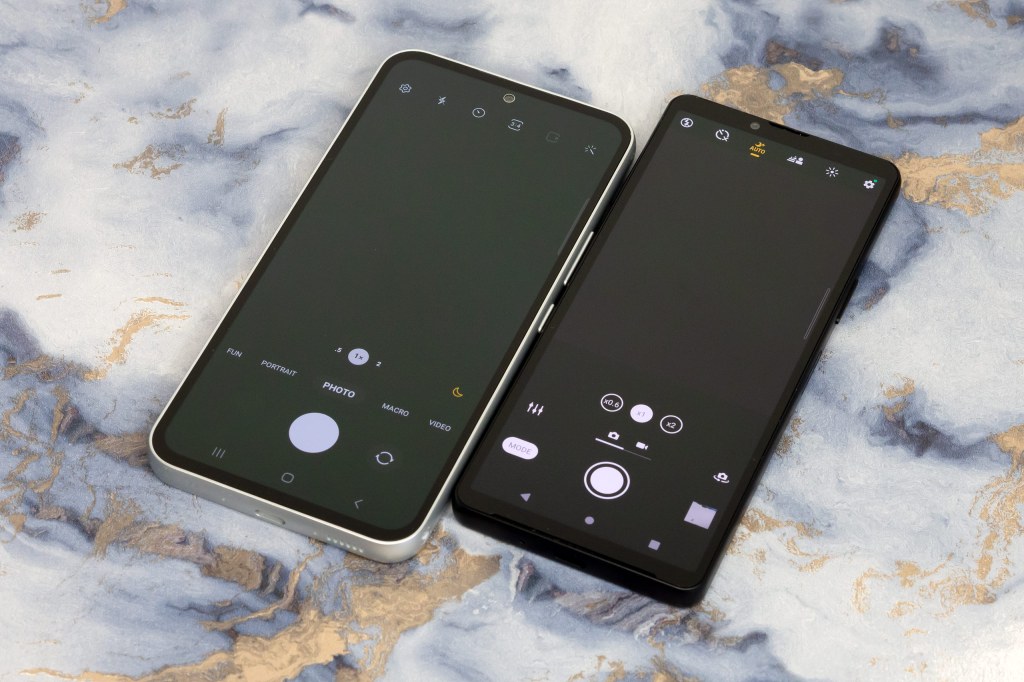
Samsung Galaxy A54 5G (left) vs Sony Xperia 10 V (right) photo apps. Photo Joshua Waller
Both offer easy to use photo apps, and both offer manual controls, letting you change settings when needed. They also both other a portrait or background blur mode, and night modes, along with auto HDR. Beyond this the Sony phone offers very few modes, whereas the Samsung offers a whole range of shooting modes that will make the phone more useful, as well as more fun to shoot with, including Fun filters, food mode, pro video, hyperlapse and more.

Samsung Galaxy A54 5G (left) vs Sony Xperia 10 V (right). Photo Joshua Waller
Samsung Galaxy A54 vs Sony Xperia 10 V Photo image quality
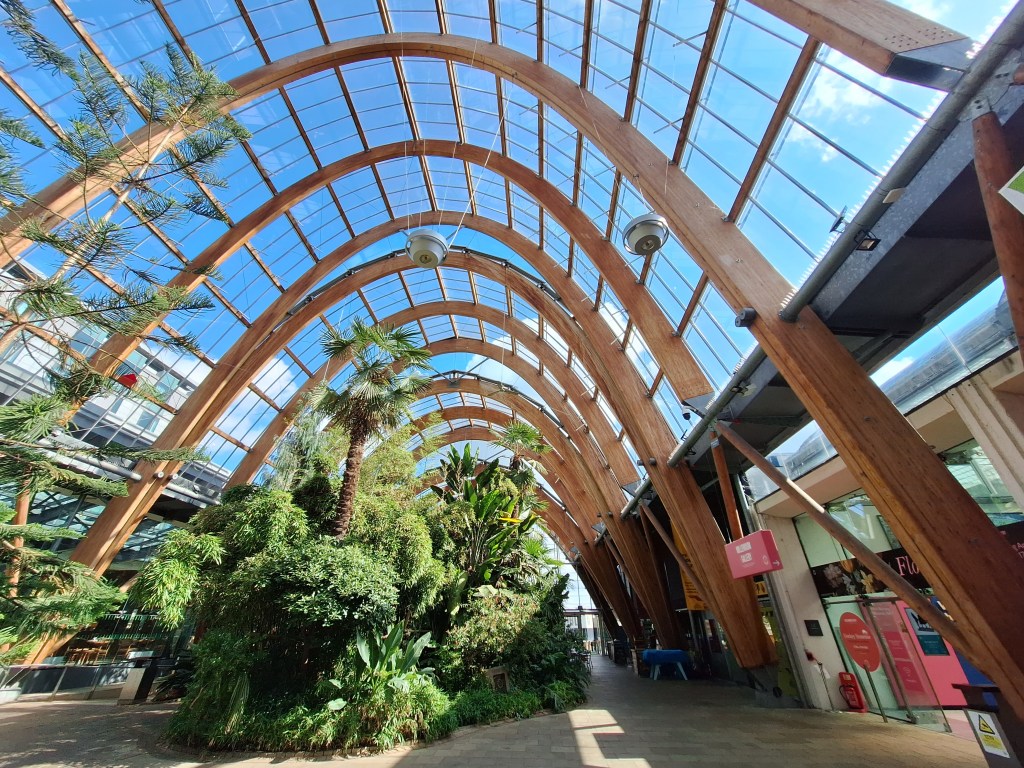
Ultra-wide-angle shot taken with the Samsung Galaxy A54. 12MP. Photo Joshua Waller
Taking the same shot with both phones, we can compare the results side-by-side and see what the strengths and weaknesses of each camera is. Here we’ve taken a photo of the same scene with the ultra-wide-angle camera on the Samsung and the Sony phones. Purple fringing can be seen on both cameras, but colour is generally good from both cameras. The Samsung gives better results here, with a higher resolution 12MP image, as well as a wider view of the scene.

Taken with the 8MP ultra-wide-angle camera, on the Sony Xperia 10 V. Photo Joshua Waller
Wide-angle main cameras compared:

Wide-angle photo taken with the Samsung Galaxy A54. Photo Joshua Waller
Comparing the main cameras on both phones, again, the Samsung gives a wider view of the scene, meaning you capture more in your photos. Colour reproduction is better from the Samsung, with a brighter image produced, and there is more detail to be found in the darker areas of the image.

Peace Gardens, wide-angle camera on the Sony Xperia 10 V. Photo Joshua Waller
The Sony gives an image with soft corners, most noticeable in the top left corner of this image.
Telephoto 2x telephoto vs 2x digital

Samsung Galaxy A54, 2x digital zoom. Photo Joshua Waller
The 2x zoom option on the Samsung uses digital zoom to produce the image, and this gives a pixelated view of the scene when viewed close-up. For sharing on social media this won’t matter too much, but it’s difficult to beat a true telephoto camera.

There is more detail visible in the 8MP photo taken with the 2x telephoto camera on the Sony 10 V.
The telephoto camera on the Sony phone offers better detail, despite only being an 8MP camera. It’s possible that if we were using a Google Pixel phone with Super Resolution Zoom, we’d be seeing different results. Colours on the Sony phone are a little bit duller, with duller reds seen here.
Low-light performance
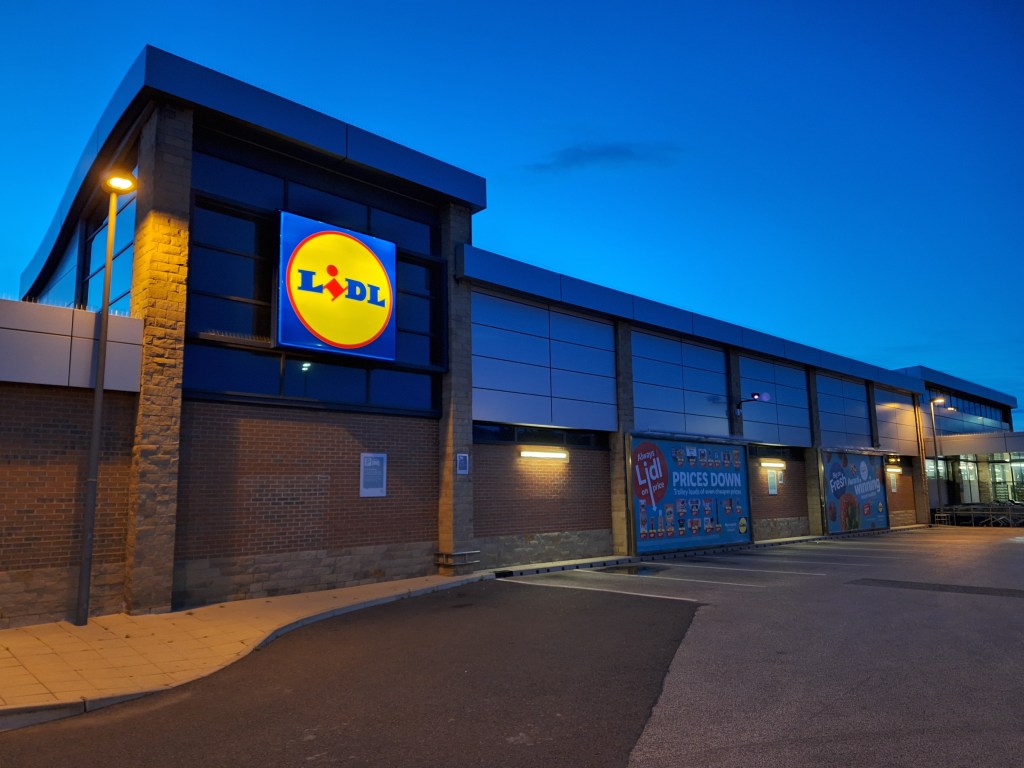
Low-light shot taken with the Samsung Galaxy A54. Photo Joshua Waller
The Samsung has a good night mode that gives a good level of detail in both the bright and darker areas of the image. It makes it possible to read the details in the billboard poster when zooming into the image.
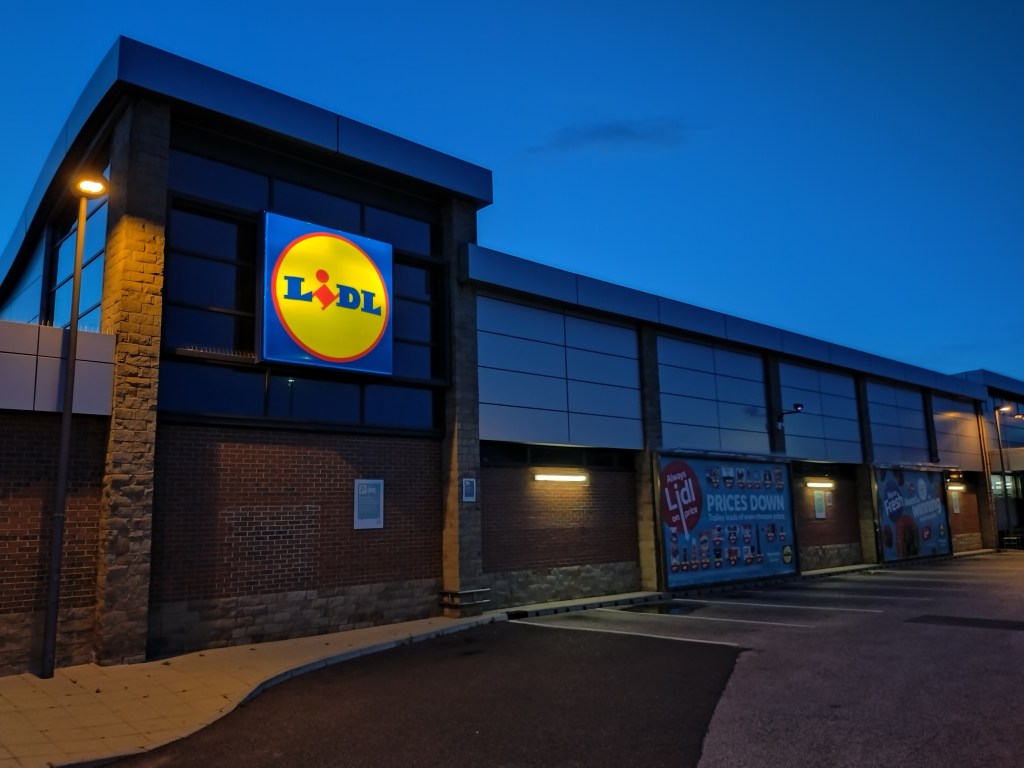
This low light shot lacks any real detail, and noise reduction is very strong. Photo Joshua Waller
In comparison the Sony’s night mode gives noticeably worse low-light images, with a soft image being produced, with muddy looking colours, as well as detail being lost in darker areas of the image.
Ultra-wide-angle comparison
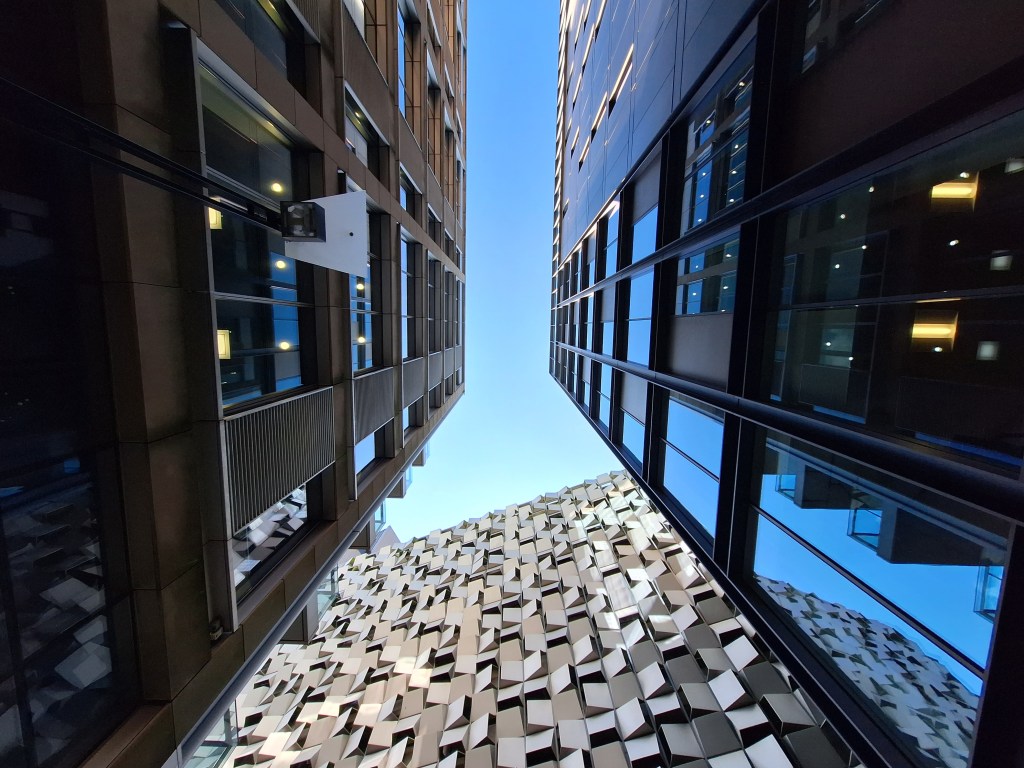
Samsung Galaxy A54, ultra-wide-angle camera. Photo Joshua Waller
Whilst at first glance the sky looks better in the Sony shot, the darker areas show high levels of noise, and lower image quality. With more detail captured by the Samsung, and better noise performance, this gives the win to the 12MP camera on the Samsung.
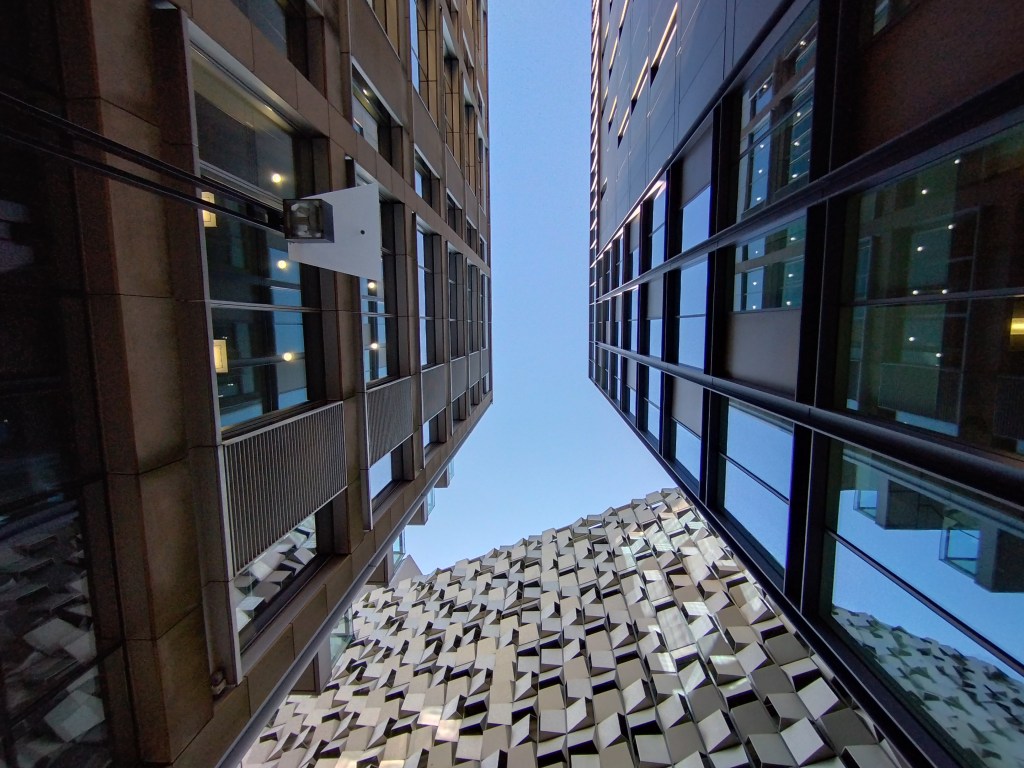
Ultra-wide-angle shot taken with the Sony Xperia 10 V. There are high levels of noise in the darker areas of this image. Photo Joshua Waller
Macro performance
The Samsung Galaxy A54 had a dedicated 5MP macro camera, which means you need to be a certain distance to get the photo in focus.

Samsung Galaxy A54 with 5MP macro camera. Photo: Joshua Waller
If the object or subject you’re taking a photo of is just the right size, and just the right distance, then the 5MP macro camera on the Samsung can take some impressive looking photos.
On the Sony, with no dedicated macro camera, you have to use the main camera, and this lets you get close-up photos. The colours look good in this image, but it’s also lacking dynamic range.

Close up photo from the Samsung Galaxy A54. Photo Joshua Waller
The same scene taken with the main camera on the Samsung shows much better dynamic range, in comparison, and you don’t have to use the dedicated macro camera to get close-up photos.
Close-up Flowers (Dynamic range and detail)

Samsung Galaxy A54 – Pink flowers taken with the main camera. Photo Joshua Waller
This scene has bright pink leaves with lots of fine detail, as well as small white flowers, with smaller yellow sections in the middle. The Samsung has captured plenty of detail

Pink flowers: Here’s one example of when the Sony Xperia 10 V camera gets things wrong.
In comparison the Sony has struggled to capture the detail in the pink leaves, and as the image is lacking dynamic range, and some of the white flowers are entirely over-exposed, although you can still see the yellow bits in the middle in some of them.
Selfie camera performance

Samsung A54 selfie camera with background blur on. Photo Joshua Waller
Both cameras output 8MP photos from the selfie camera, however the Samsung Galaxy A54 uses a 32MP camera that using pixel-binning to produce it’s 8MP photos. This means it’s starting with an image that has more detail, and this shows in the results.

Selfie taken with the Sony Xperia 10 V. The photo taken immediately after this lacked the same dynamic range.
Sony’s selfie camera has an 8MP sensor, and an F2.0 lens. There are background blur options available, and results can be good, with auto HDR helping improve dynamic range, however this is only visible after you’ve taken the photo.
Detail is low, with very low levels of detail on the face and skin. You’d think that the skin softening option was switched on, but I’ve checked numerous times and it’s not switched on. In lower light, the low levels of detail become even more apparent.
Samsung selfie, indoors:

Samsung Galaxy A54 selfie camera. Indoors. (ISO640, f/2.2, 1/25sec)
In low-light, there is more detail from the selfie camera on the Samsung, when compared to the Sony, although the image is a bit redder that ideal.
Sony selfie, indoors:

Selfie taken with the Sony Xperia 10 V indoors, in low-light.
The selfie taken with the Sony is lacking detail, and colours are a little duller.
Samsung Galaxy A54 vs Sony Xperia 10 V video performance
Samsung A54 video:
The Samsung Galaxy A54 records 4K video, with plenty of detail. It offers good levels of dynamic range, as well as good stabilisation performance.
Sony Xperia 10 V video:
In comparison, the Sony Xperia 10 V only records at Full HD resolution, and stabilisation struggles to keep the footage stable. There’s also much less detail captured in the video.
Samsung Galaxy A54 vs Sony Xperia 10 V Screen and design

Samsung Galaxy A54 5G (left) vs Sony Xperia 10 V (right) photo editing. Photo Joshua Waller
The A54 features a 6.4inch screen, which doesn’t sound like a big difference between the 6.1inch screen, however, the aspect ratio difference between the two phones means that the Sony Xperia 10 V is a similar height, but much narrower. This has a knock on effect of making the 4:3 aspect ratio photos look tiny when in the middle of the 21:9 aspect ratio Sony screen. This makes the Samsung a much better experience for photography as the view is much larger.
Samsung Galaxy A54 vs Sony Xperia 10 V Battery life
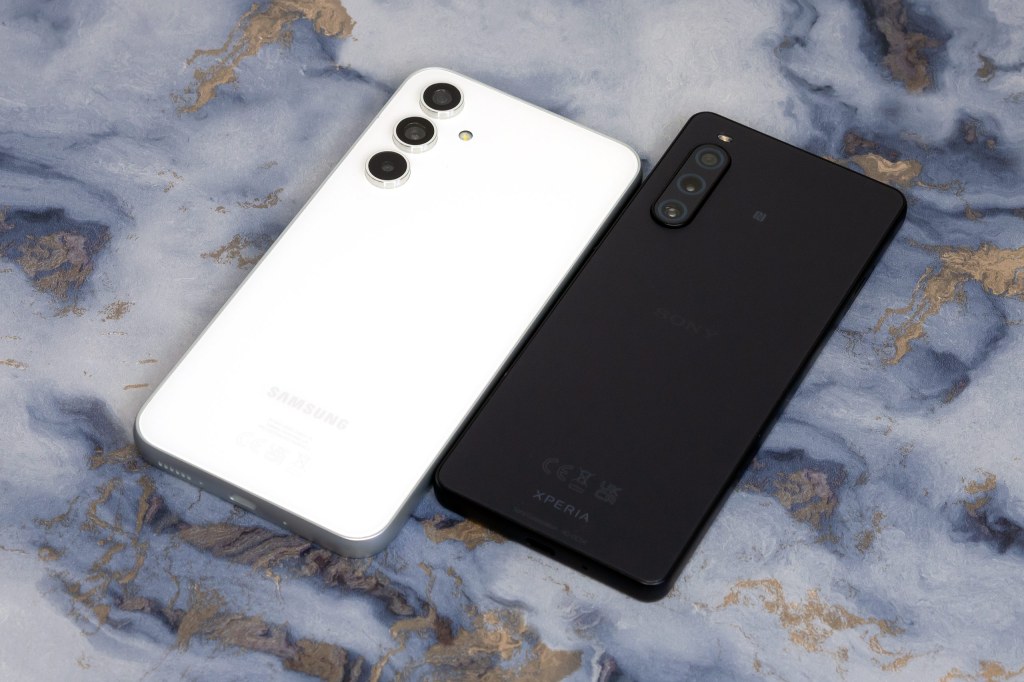
Samsung Galaxy A54 5G (left) vs Sony Xperia 10 V (right) rear. Photo Joshua Waller
Both phones feature a 5000mAh battery, which is a generous amount, and better than a large number of phones, so both phones offer good battery life. However, the Sony Xperia 10 V has some impressive battery management, that means that when you’re not using the phone, the battery seems to last an incredible mount of time. Sony also say that their battery management means the battery should stay healthy for a lot longer than phones without this management.
Price
Shop around and you’ll find the Sony Xperia 10 V priced at $449 in the US, or £399 in the UK. This makes it Sony’s cheapest new phone. However, you can also find the Samsung Galaxy A54 for $449 in the US, or £449 in the UK. We’d expect both phones to come down in price over time, however, with Samsung being more widely available, it’s likely there will be more offers available.
Samsung Galaxy A54 vs Sony Xperia 10 V Verdict
Counting the wins and losses, the Samsung Galaxy A54 5G wins almost every category, with a couple of draws, and only one loss in the comparison, and that’s for the telephoto zoom. It’s pretty clear which one of these mid-range phones is the better choice.
It’s also in important areas where the Samsung beats the Sony, with a better main camera, better ultra-wide angle camera, better selfie camera, significantly better video, as well as better dynamic range and colour. There’s also better low-light performance from the Samsung, as well as a dedicated 5MP macro camera.
The only area where the Samsung falls behind the Sony, is in 2x (digital) zoom performance, which doesn’t match the detail possible with the 2x telephoto camera on the Sony. However, we wouldn’t really see this as a reason to go for the Sony.
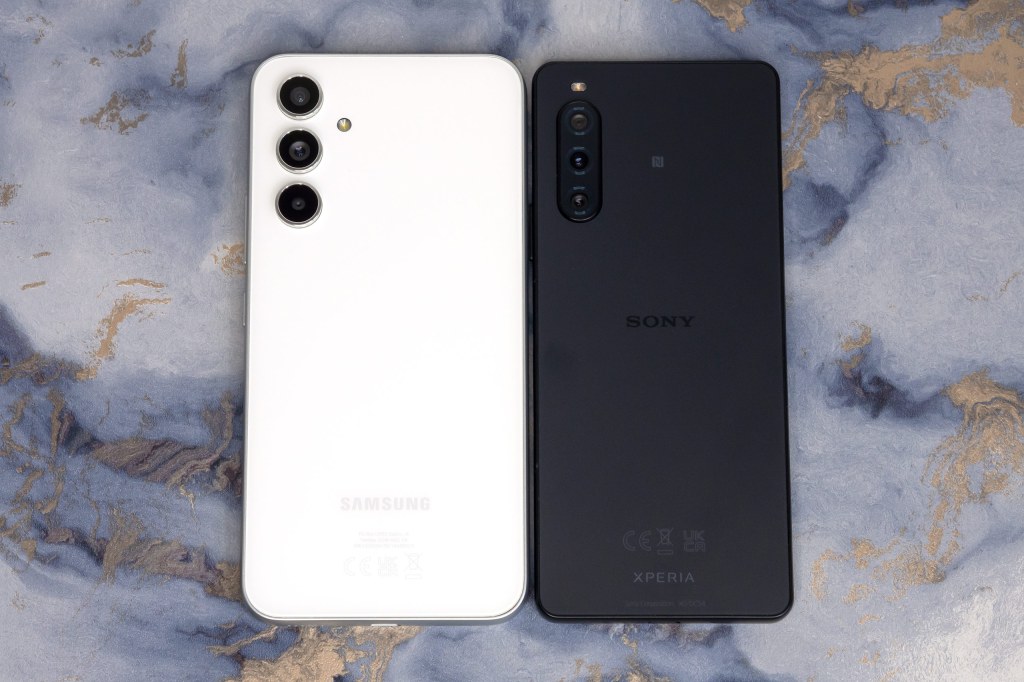
Samsung Galaxy A54 5G (left) vs Sony Xperia 10 V (right). Photo Joshua Waller
There are other areas where the Samsung makes a better choice as well, outside of just the camera and video performance, and these are worth noting. For example, the Samsung feels like a much quicker phone to use, and this is also noticeable when taking photos. The Samsung also offers longer OS and security updates compared to the Sony.
Read our full Samsung Galaxy A54 5G review
Read our full Sony Xperia 10 V review
Find more options in our guide to the best budget and mid-range phones.
Follow AP on Facebook, Twitter, Instagram, YouTube and TikTok.








